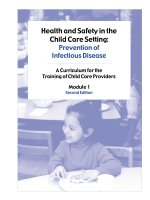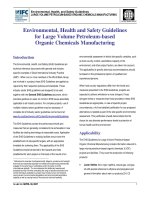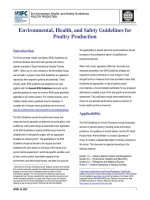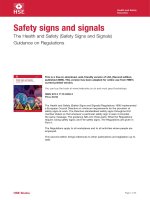Health and safety training expectations PDF KB
Bạn đang xem bản rút gọn của tài liệu. Xem và tải ngay bản đầy đủ của tài liệu tại đây (100.77 KB, 5 trang )
Health and Safety Instruction and Training
University Expectations for the Provision and Recording of Health
and Safety Instruction and Training
Underpinning Principles
The health and safety instruction and training needs of all members
of staff and students should be identified and appropriate
instruction/training provided.
The responsibility to ensure that health and safety
instruction/training needs are identified and actioned rests with
strategic managers (SPARG), Heads of School and Department and
‘next level’ heads of division/section etc. The actual activity can be
delegated through the normal line management chain but
responsibility for ensuring compliance rests with strategic
managers.
Records of all health and safety instruction/training should be kept
at School/Department level, should normally be in writing and
should contain confirmation, by those receiving the
instruction/training, that it has been received and understood.
Context
The university’s arrangements for providing and recording health and
safety instruction and training have been reviewed by our insurers as part
of a planned audit process. The auditors have made recommendations for
improvements in the way we identify instruction and training needs and
record training activity and certain recommendations have been accepted.
By following this guidance Schools and Departments will be satisfying the
recommendations.
University Expectations
The university is committed to the provision of a healthy and safe
environment to facilitate interesting and challenging work and study.
The following statement, giving more detail on the health and safety
instruction and training expectations outlined above, is contained within
the health and safety web page “Arrangements for Health and Safety
Management”.
“Health and safety related training will, so far as possible, be planned and
organised with the involvement of the relevant stakeholders. However,
responsibility for appropriate health and safety training for key personnel
and day-to-day operational activity rests with the Head of School or
relevant senior departmental manager.
RGU will determine and specify relevant health & safety training
requirements for key staff at all levels. The EPR process and discussions
with Line Managers highlight training requirements and appropriate
training will be provided, where there is a requirement by RGU or the
School or Department.”
The specific responsibility of Senior Managers to meet this requirement is
detailed below in the extract from the supporting web page “Management
Structure”.
“Strategic Managers, School, Department and Unit Heads, and
Department and Section Heads are, as part of their contract of
employment, responsible for ensuring that all activities under their control
are carried out in accordance with the University Safety Policy, standards
and procedures; and in compliance with statutory provisions, by:
Ensuring staff are competent and capable of performing their duties
to the required standard and adequate training is provided to
ensure competency is maintained.”
What is H&S Training?
The Health & Safety Executive (HSE) define training as:
“… helping people to learn how to do something, telling people what they
should or should not do, or simply giving them information. Training isn’t
just about formal “classroom” courses.”
Health and safety instruction and training can take a wide range of
formats depending on the target audience and the topic being addressed.
It can range from structured, formal events through to team briefings or
“one-to-one” on the job training or even the provision of written
information. It would include:
General induction and orientation on first appointment
Specific instruction and/or training for the role and activity
Refresher instruction and/or training where this is appropriate to
the activity
Instruction and/or training where the environment and/or location
for an activity, processes, procedures, equipment changes
materially
‘Tool box’ talks providing information and/or instruction to a team
Internal/external courses or other instructional events
Formal training for a wider group organised at university level
E-learning
Similar and equivalent instructional/training activity
Who Needs H&S Instruction and/or Training?
Every member of staff requires some degree of H&S training. As a
minimum this should consist of the instruction and/or training embedded
in the university induction process which contains links to the H&S policies
and procedures as well as the fire safety training module. This induction
should be supplemented at local school or department level if additional
elements or features exist in that specific environment.
Additional instruction/training will also be required for many staff
members depending on the more specific tasks which these individuals
will be undertaking. This additional requirement should be determined at
the local level by the manager/team leaders in control of those activities,
considering the hazards, associated control/mitigation measures and
residual risks arising from those activities.
Students also require health and safety instruction/training and it is
expected that they will undergo a structured induction process at the start
of their studies, appropriate to their environment. Also that any post
induction instruction/training, required for undergraduates, will be
embedded in their course of study.
In the case of postgraduate students the post induction
instruction/training requirements may vary widely and will have to be
determined at school or institute level. The requirement will depend on
the academic discipline of the student and the range of tasks undertaken
by that individual as part of their studies. It will usually be necessary for
the head of school or institute director or research team leader to identify
the instruction/training needs of each individual in conjunction with the
student and their other academic supervisors. The exception would be
where the postgraduate student is part of a taught cohort and the
assessment of their needs can be treated in the same manner as an
undergraduate student.
How Do You Identify The H&S Instruction Training Required?
Induction training
All schools and departments should ensure that the common university
induction process is followed and recorded. The induction training
checklist should be extended to include the essential and particular
training which they have decided is required in their area of control and
for the specific role.
The expectation is that induction instruction and training will normally be
completed during the first few days of employment or taking up a new
position. This is essential where there are known specific risks that the
employee may be immediately exposed to.
The aim is to ensure everyone has the information they require on the:
Hazards and risks they may face
Measures in place to eliminate, mitigate or otherwise deal with
those hazards and risks, including approved safe working practices
How to follow any emergency procedures which may apply.
Specific H&S Instruction/Training Needs
The head of school or department should ensure that more specific H&S
instruction and training needs within their area of control are properly
assessed. This exercise can be conducted within the units by the line
management chain under the supervision of the local senior manager,
subject to being satisfied as to line management competence. The
expected output of this assessment is that the core instruction/training
needs for each individual in their role, and the environment they operate
in, are identified, undertaken and recorded on completion.
The individual plan and record should incorporate a suitable and realistic
forward instruction/training plan which is actioned within an agreed and
stated timescale according to priorities established by the assessment.
The plan and record should thus allow for refresher instruction/training, a
regular review of training needs and the future development of the
individual. All of this necessarily must also take account of evidence of
prior competent experience but there is normally no role in the university
where refresher instruction/training is not needed from time to time.
Examples of specific/additional instruction/training needs could include:
specific laboratory based procedures
waste handling
manual handling training
gas bottle handling
operation of wood working machines
operation of lasers/x-ray equipment etc
use of cryogens
use of gases, chemicals
use of other specialist equipment
particular aspects of electrical safety
selection and use of PPE
procedural, regulatory instruction/training such as risk assessment
training, Legionella controls, asbestos awareness, GMO protocols,
etc.
It is not possible to give a prescriptive list of instruction/training
requirements as roles and the environment within which they
operate, vary so much. This is why proper assessment of need is
essential.
This specific/additional training should be prioritised and planned on the
basis of risk and operational requirements but it is expected that such
instruction/training will be carried out over a period of weeks or months
as the individual settles into their new role. Where there are identified
gaps for existing staff it would be expected these would be similarly
prioritised according to risk but still ‘planned in’ on agreed timescales as
individuals or in groups.
Records of H&S Instruction/Training
A record system is required to document the H&S instruction / training
needs identified for each individual or group and to demonstrate that all
the required training has been provided or that an agreed programme is
in place to complete it.
The H&S instruction/training record is an individual record and therefore
should transfer with the individual it concerns should they move to a new
School / Department / Unit within the university. It is expected that this
record will be held at local level but with broadly common content which
will allow the compilation of information when required by the university,
our insurers or an external regulatory body. An example of the suggested
common content is attached. As long as the content is covered the format
is less important just now as, in due course, we will move to a universitywide common on-line record system in a common format also.
The H&S instruction/training record should be signed by the individual it
concerns to confirm that they have received and understood the
instruction/training given. In addition, the record should be countersigned by their direct line manager to confirm that appropriate
instruction/training has been provided. The head of the school or
department should review the instruction/training plans and records of
staff within their area of control at regular intervals and ensure that any
outstanding actions are closed off within the agreed timescale in the plan.
Further guidance and advice from:
Dr Harris Cooper, Head of Occupational Health and Environmental Safety
Contact: 01224 262086









